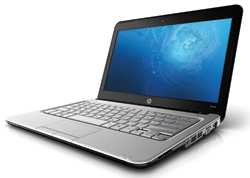Details on HP's Ion-powered netbook, Windows XP not dead yet

Almost nine months to the day after Nvidia announced its Ion Platform, the first real netbook to make use of the technology has finally shipped. HP announced the Mini 311, an 11.6-inch netbook that pairs Intel's Atom processor with Ion, which is based on the GeForce 9400M GPU. Ion should give netbooks a significant performance boost, though this could come at the expense of battery life. HP announced several other netbooks (it uses the name "companion PC") and laptops including a new Envy premium series and a couple of thin-and-light models using the latest Intel ULV and AMD ultra-thin technology. (I'll cover the laptops in a separate post.)
The Mini 311 will get the most press because of Ion. Nvidia claims that 50 Ion-based products will be released this year, but many of those are net-tops, and so far only two other major players, Lenovo and Samsung, have publicly committed to releasing Ion netbooks this year. Back in May Nvidia and Lenovo said the IdeaPad S12 would be the first, but Lenovo recently said it would wait for Windows 7 (Netbooks with Nvidia's Ion wait on Windows 7). Samsung said it would also wait until late October, which is why HP's decision to release the Mini 311 now with Ion and Windows XP is a bit of a surprise, despite the steady stream of leaks over the past couple weeks.

The Mini 311 starts at $400 with the usual netbook specs: 11.6-inch display (1366x768), 1.60GHz Intel Atom N270, 1GB of memory, 160GB hard drive and Windows XP Home SP3. It will be available on September 23. On October 18, HP will ship a version of the Mini 311 with Windows 7 Premium--not Starter Edition--starting at $475. This will be one of the first tests of Windows 7 pricing. Analysts have been obsessing over whether Microsoft and its hardware partners can really entice buyers who are currently snapping up netbooks with $15 copies of Windows XP to spend more on Windows 7. The design of the Mini 311 is similar to current models (why mess with a good thing?) with a near full-size keyboard. It weighs 3.2 pounds and measures 11.4 by 8.0 by 0.8-1.2 inches.
HP's other new netbook companion PC, the Mini 110, is less interesting technologically, but it shows how HP and others will try to differentiate their Windows 7 systems. In this case HP worked with a Dutch designer, Tord Boontje, to customize the 10.1-inch model. The case is etched with a three-dimensional Boontje design, and you can choose from custom set of wallpaper options that match the case design. Aside from Windows 7 Starter Edition, the guts of this model are identical to the current Mini 110 (1.60GHz Atom N270, 1GB and 160GB hard drive). It will also be available on October 18 for $399. By comparison, the plain vanilla Windows XP version currently sells for $330. Someone must be buying these customized netbooks since HP recently previewed new versions of its Vivienne Tam "digital clutch" at Fashion Week in New York.